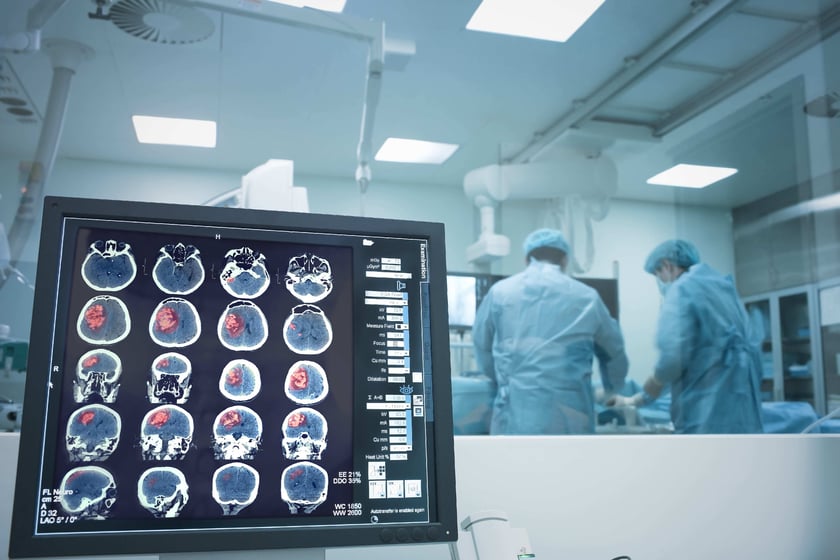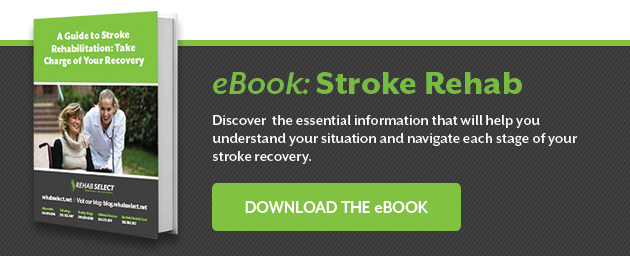
Strokes are one of the leading causes of long-term disability in the U.S., affecting nearly 800,000 Americans every year. Recovering from the severe side effects caused by strokes can be a long and arduous process, requiring intensive rehabilitative therapy.
Download the Stroke Rehabilitation eBook
However, the good news is that there have been several recent breakthroughs in new stroke therapy and new stroke treatment, which may lead to significant improvements in the quality of life and health outcomes of stroke patients. Here are five of the most important advances in stroke recovery:
1. Thrombectomy After 6 Hours
A thrombectomy is a surgical procedure to remove a blood clot from a blood vessel — usually a cerebral artery. Previously, it was thought that thrombectomies were only a viable option for patients within the first six hours of a stroke. However, recent trials have revealed that thrombectomy can be helpful for patients even up to 24 hours after a stroke, improving the likelihood that they will recover functional independence. Coupled with guidelines from the American Heart Association encouraging Emergency Medical Service professionals to take stroke patients to hospitals where thrombectomies can be performed, this new stroke treatment standard could reduce the severity of stroke symptoms for many patients.
2. Vagus Nerve Stimulation
A recent study reported in the Stroke journal found that, when coupled with physical rehabilitation, a new stroke treatment called vagus nerve stimulation could more than double the rate of recovery for patients with impaired upper limbs. During the pilot study, patients were implanted with a medical device that delivered electrical impulses to their vagus nerve, a long nerve that controls varied tasks including heart rate, peristalsis, sweating and several muscle movements, including speech-related mobility. Dr. Kimberley, the director of the Brain Recovery Lab at Massachusetts General Hospital, explains,
"The theory is that the vagus nerve, when it's stimulated, releases neurotransmitters into the brain. So if you're trying to open your hand, all the neurons in your brain that are associated with hand-opening are trying to work, and those neurons have extra neurotransmitters available to help strengthen that synaptic connection."
While more research is needed, this new stroke therapy could have significant positive implications for stroke rehabilitation.
3. Repetitive Transcranial Magnetic Stimulation
Repetitive transcranial magnetic stimulation (rTMS) is a non-invasive procedure, in which an electrode is held near the patient's head and magnetic pulses are sent through to the brain. It has been used for over 20 years for the treatment of severe depression. Recent research has found that it can also form a highly effective component of stroke rehabilitation. In a study published in Frontiers in cellular neuroscience, researchers demonstrated that:
"High-frequency rTMS in stroke patients can be used to promote functional recovery by inducing the endogenous repair and recovery mechanisms of the brain."
4. Virtual Reality
New neuromodulation techniques are not the only advances in stroke recovery. Virtual reality systems may also be useful in helping restore brain function after strokes. These tools offer several benefits to stroke patients:
- They are a cost-effective way of continuing rehabilitative treatment in their own homes once they have completed an in-patient program;
- They allow patients to direct their rehab treatment, meaning that they can control the pace themselves;
- As they are based on gaming principles, they are often fun to use and helpfully habit-forming.
A research study reported in the Journal of NeuroEngineering and Rehabilitation found that some VR systems "showed significant impact on upper-limb recovery as compared to standard therapy." Not all tools are created equal, of course – a meta-analysis of the VR systems currently being used experimentally for stroke rehab found that only those designed specifically for post-stroke treatment demonstrated any significant results.
5. Umbilical Cord Infusions
Research published in the Journal of Stem Cells Translational Medicine found that a single infusion of umbilical cord blood was both safe and helpful in the treatment of ischemic strokes. Umbilical blood is rich in mesenchymal stem cells, the parent cells of all tissue cells in the human body, and therefore, the cells most helpful in the treatment of brain injuries. The discovery was based on previous research which found that an infusion of infant plasma could help slow the process of brain aging in animals; researchers theorized that umbilical cord blood might, therefore, stimulate the development of new neuronal activity in stroke patients.
Stroke Prevention
While these advances in stroke recovery may have a radical impact on stroke treatment, perhaps even more important are the breakthroughs being made in preventing strokes in the first place. Researchers in England report that the overall number of strokes fell by 55% between 2001 and 2010, owing to an increase in preventative medical interventions, such as the use of statins to control blood pressure in at-risk groups. Harvard University researchers have also provided a list of self-care measures people can take to avoid stroke, including:
- Lowering blood pressure by preventing high-cholesterol and excess salt;
- Maintaining a healthy weight;
- Quitting smoking;
- Reducing alcohol intake;
- Increasing exercise;
- Managing chronic conditions, such as diabetes and atrial fibrillation.
New Stroke Treatment in Alabama
Exciting new stroke treatment promises to improve the quality of life of the thousands of people struggling with the after-effects of a stroke. However, it is worth noting that new stroke therapy is most effective when combined with both medical intervention and a personalized program of physical and cognitive rehab, provided at a specialist post-stroke rehab facility.
If you would like to find out more about the stroke rehabilitation treatments available at Rehab Select facilities across Alabama, please click here to visit our website or click here to contact us.




